java怎么实现评论和回复功能
效果展示
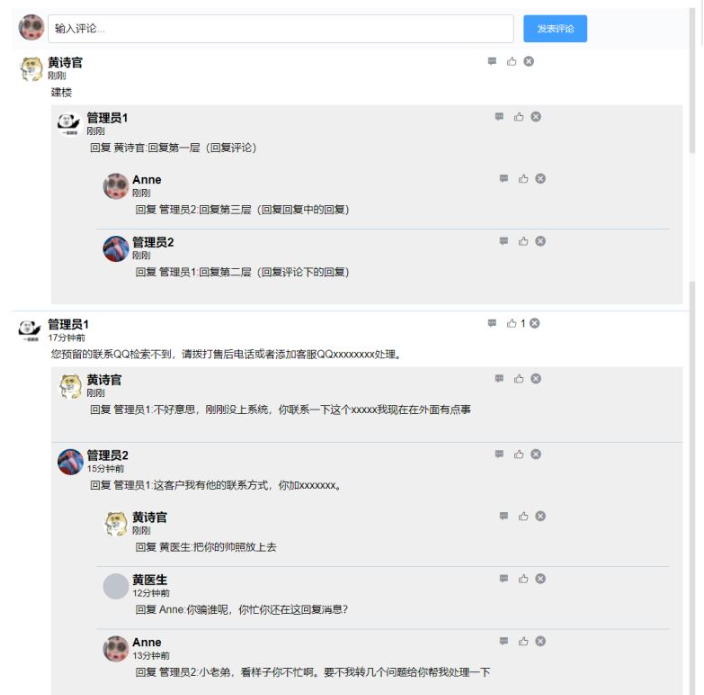
总共是两层回复 (回复评论、回复评论下的回复)
数据库设计
评论表(TFW_Comments)和回复内容表(TFW_UserResponse)以及评论回复关系表(TFW_MsgRelation)
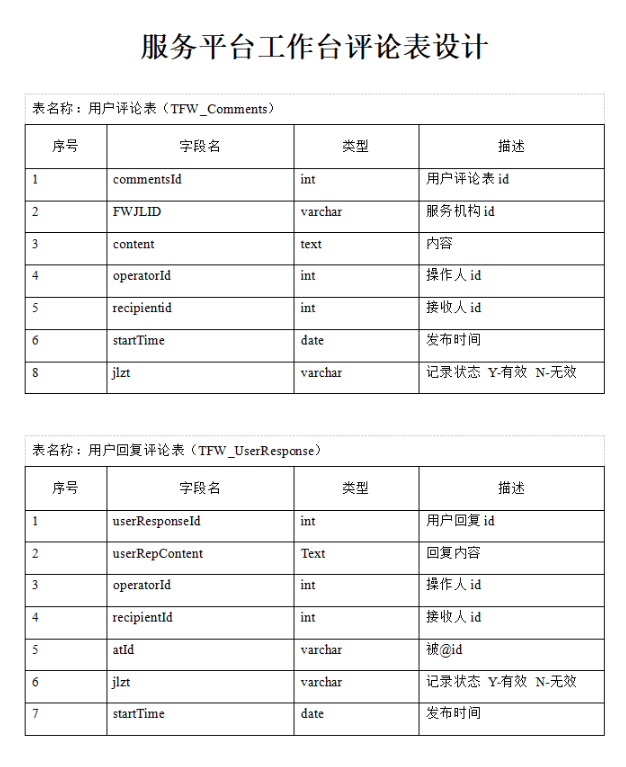
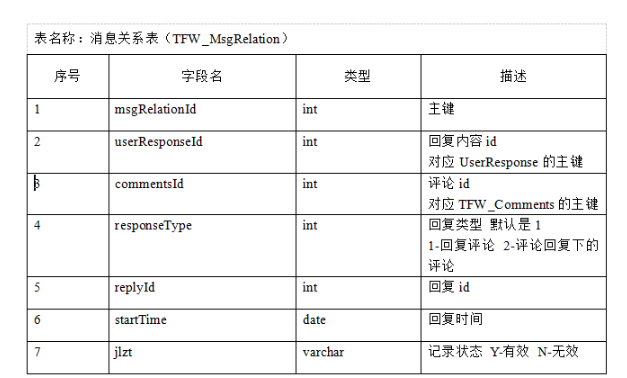
数据库设计思路:
注:各位读者自动忽略评论表的服务机构ID字段,这个字段相当于这条评论是在哪个帖子(文章下面)
1、根据文章ID或者是帖子ID查询评论表获取评论(本文的服务机构ID)。第一层(评论)
获取第二层回复(commentsId),需要根据评论ID并且回复类型等于1,在关系表中查询。第二层(评论下的回复)
根据评论ID、回复类型为2、以及回复ID在关系表中获取第三层回复信息。第三层(评论下回复中的回复)注:回复ID是它的上级
实现类源码
@Override
public Map<String, Object> findComments(JSONObject jsonObject) {
data.clear();
String userId = jsonObject.getString("userId");
String role = this.role(jsonObject);
if (role.equals("-1")){
//没有权限
data.put("error","-1");
data.put("msg","当前用户没有权限");
return data;
}
List<Map<String, Object>> info = commentsDao.findComment(jsonObject.getString("fWJLID"),null);
//查询点赞次数
int countTag = 0;
MsgRelationTag msgRelationTag = new MsgRelationTag();
for (Map item : info){
item.put("inputShow",false);
int commentsId = (int) item.get("commentsId");
//查询点赞次数
countTag = msgRelationDao.findCountTagByTagId(commentsId,1);
item.put("countTag",countTag);
//设置点赞状态
msgRelationTag.setTagId(commentsId);
msgRelationTag.setTagType(1);
msgRelationTag.setTagUserId(Integer.parseInt(userId));
MsgRelationTag msgTag = msgRelationDao.findMsgTag(msgRelationTag);
if (msgTag != null) {
item.put("tagStatus",msgTag.getStatus());
}else {
item.put("tagStatus","");
}
//如果有@id
if (item.get("atId") != null){
String content = item.get("content").toString();
StringBuffer tmrAtId = findUserName(item.get("atId").toString());
item.put("content",content+'@'+tmrAtId);
}
//二级回复数据
List<Map<String, Object>> twoReply = new ArrayList<>();
//所有数据
List<Map<String, Object>> userResponse = userResponseDao.findUserResponse(commentsId, null, "","",null);
for (Map userResponseInfo :userResponse){
int userResponseIds = Integer.parseInt(userResponseInfo.get("userResponseId").toString());
//查询点赞次数
countTag = msgRelationDao.findCountTagByTagId(userResponseIds,2);
//设置点赞状态
msgRelationTag.setTagId(userResponseIds);
msgRelationTag.setTagType(2);
msgTag = msgRelationDao.findMsgTag(msgRelationTag);
if (msgTag != null) {userResponseInfo.put("tagStatus",msgTag.getStatus());}else {userResponseInfo.put("tagStatus","");}
userResponseInfo.put("countTag",countTag);
userResponseInfo.put("inputShow",false);
Integer responseType = (Integer) userResponseInfo.get("responseType");
for (Map stairReplyInfo : userResponse){
Integer userResponseId = (Integer) stairReplyInfo.get("userResponseId");
int msgRelationId = Integer.parseInt(stairReplyInfo.get("msgRelationId").toString());
//接受者id*/
twoReply = userResponseDao.findUserResponse(msgRelationId, userResponseId,"1","",null); //二级回复数据
for (Map twoReplyItem : twoReply){
int twoReplyId = Integer.parseInt(twoReplyItem.get("userResponseId").toString());
twoReplyItem.put("inputShow",false);
//查询点赞次数
countTag = msgRelationDao.findCountTagByTagId(twoReplyId,2);
twoReplyItem.put("countTag",countTag);
//设置点赞状态
msgRelationTag.setTagId(twoReplyId);
msgTag = msgRelationDao.findMsgTag(msgRelationTag);
if (msgTag != null) {twoReplyItem.put("tagStatus",msgTag.getStatus());}else {twoReplyItem.put("tagStatus","");}
String userRepContent = twoReplyItem.get("userRepContent").toString();
if (twoReplyItem.get("tmrAtId") != null){
StringBuffer tmrAtId = findUserName(twoReplyItem.get("tmrAtId").toString());
twoReplyItem.put("userRepContent",userRepContent+'@'+tmrAtId);
}
}
stairReplyInfo.put("twoReply",twoReply);
}
}
item.put("stairReply",userResponse);
}
data.put("data",info);
data.put("error",0);
data.put("msg","查询成功");
return data;
}其它的代码可以忽略。主要语句有:
获取帖子下的评论
List<Map<String, Object>> info = commentsDao.findComment(jsonObject.getString("fWJLID"),null);上图根据FWJLID获取评论。(此处可以当成帖子的ID,获取帖子下的评论)一级展示
对应SQL语句(OPT是我的用户表)
select tc.content ,tc.commentsId,convert(varchar(19),tc.startTime,120) as startTime,tc.recipientId ,tc.operatorId,zo.NAME as operatorName,tc.atId,zo.HeadImgUrl as operatorHeadImgUrl
from TFW_Comments tc
left join zd_opt zo on zo.AID = tc.operatorId where tc.FWJLID = 5101查询结果:

获取评论下的回复
List<Map<String, Object>> userResponse = userResponseDao.findUserResponse(commentsId, null, "","",null);
上图根据commentsid获取评论下的回复。(根据评论ID获取回复)二级展示
对应sql语句
select
tur.userResponseId,tur.operatorId,tur.recipientId,convert(varchar(19),tur.startTime,120) as startTime,tur.userRepContent,tmr.atId as tmrAtId,
tmr.msgRelationId ,tmr.responseType,tmr.replyId,
zo.NAME as operatorName,
zo1.NAME as recipientName,
zo.HeadImgUrl as operatorHeadImgUrl,
zo1.HeadImgUrl as recipientHeadImgUrl
from TFW_MsgRelation tmr
left join TFW_UserResponse tur on tur.userResponseId = tmr.userResponseId
left join zd_opt zo on zo.AID = tur.operatorId
left join zd_opt zo1 on zo1.AID = tur.recipientId where tmr.commentsId = 47查询结果

获取二级回复
twoReply = userResponseDao.findUserResponse(msgRelationId, userResponseId,"1","",null); //二级回复数据
上图是根据评论ID(msgRelationId)和回复ID(userResponseId)去获取二级回复。回复ID也就是父类。就是回复那一条回复的ID。 第三层展示
对应sql
select
tur.userResponseId,tur.operatorId,tur.recipientId,convert(varchar(19),tur.startTime,120) as startTime,tur.userRepContent,tmr.atId as tmrAtId,
tmr.msgRelationId ,tmr.responseType,tmr.replyId,
zo.NAME as operatorName,
zo1.NAME as recipientName,
zo.HeadImgUrl as operatorHeadImgUrl,
zo1.HeadImgUrl as recipientHeadImgUrl
from TFW_MsgRelation tmr
left join TFW_UserResponse tur on tur.userResponseId = tmr.userResponseId
left join zd_opt zo on zo.AID = tur.operatorId
left join zd_opt zo1 on zo1.AID = tur.recipientId where tmr.commentsId = 136 and tmr.replyId = 155查询结果

返回页面展示和返回体展示
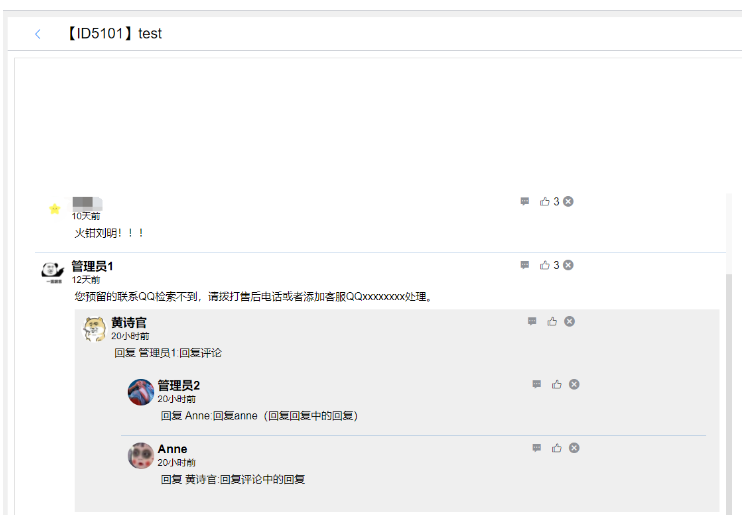
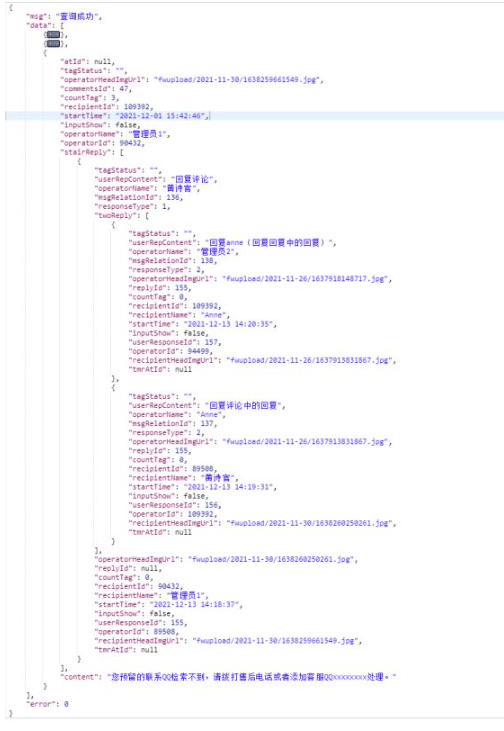
以上是java怎么实现评论和回复功能的详细内容。更多信息请关注PHP中文网其他相关文章!

热AI工具

Undresser.AI Undress
人工智能驱动的应用程序,用于创建逼真的裸体照片

AI Clothes Remover
用于从照片中去除衣服的在线人工智能工具。

Undress AI Tool
免费脱衣服图片

Clothoff.io
AI脱衣机

AI Hentai Generator
免费生成ai无尽的。

热门文章

热工具

记事本++7.3.1
好用且免费的代码编辑器

SublimeText3汉化版
中文版,非常好用

禅工作室 13.0.1
功能强大的PHP集成开发环境

Dreamweaver CS6
视觉化网页开发工具

SublimeText3 Mac版
神级代码编辑软件(SublimeText3)
 突破或从Java 8流返回?
Feb 07, 2025 pm 12:09 PM
突破或从Java 8流返回?
Feb 07, 2025 pm 12:09 PM
Java 8引入了Stream API,提供了一种强大且表达力丰富的处理数据集合的方式。然而,使用Stream时,一个常见问题是:如何从forEach操作中中断或返回? 传统循环允许提前中断或返回,但Stream的forEach方法并不直接支持这种方式。本文将解释原因,并探讨在Stream处理系统中实现提前终止的替代方法。 延伸阅读: Java Stream API改进 理解Stream forEach forEach方法是一个终端操作,它对Stream中的每个元素执行一个操作。它的设计意图是处













